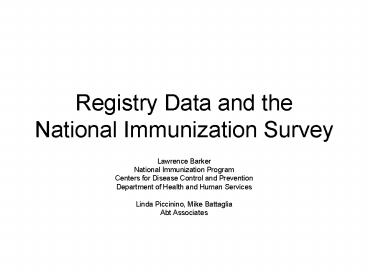Registry Data and the National Immunization Survey - PowerPoint PPT Presentation
1 / 15
Title:
Registry Data and the National Immunization Survey
Description:
Registry Data and the National Immunization Survey. Lawrence Barker ... Duplicative (or otherwise erroneous) entries in registries ... – PowerPoint PPT presentation
Number of Views:39
Avg rating:3.0/5.0
Title: Registry Data and the National Immunization Survey
1
Registry Data and the National Immunization Survey
- Lawrence Barker
- National Immunization Program
- Centers for Disease Control and Prevention
- Department of Health and Human Services
- Linda Piccinino, Mike Battaglia
- Abt Associates
2
Overview
- Description of National Immunization Survey
(N.I.S.) - Comparison of N.I.S. and Registry Data
- Findings
- N.I.S. data can be used to track progress toward
the Healthy People 2010 registry goals (N.I.S.
shows that registry data are good but can stand
improvement) - Registry data can be used to benefit N.I.S.
(registries contain some vaccines not reported to
N.I.S.)
3
National Immunization Survey
- The N.I.S. is the nations primary tool for
assessing immunization coverage among 19 to 35
month old children - The N.I.S. yields estimates of national, state,
and selected urban area coverage for vaccines and
vaccine series (for example, 43133, 4 doses
of DTaP,3 doses of polio vaccine, 1 dose of
MCV, 3 doses of hib, 3 doses of hep B)
4
N.I.S. is More Than One Survey...
- Nashville
- Milwaukee
- NYC
- Boston
- Cleveland
- Chicago
- Indianapolis
- Memphis
- Dallas
- San Jose
- Los Angeles
- San Diego
- Phoenix
- El Paso
- San Antonio
- Houston
- Seattle
- Detroit
- Boston
- Newark
- Philadelphia
- Baltimore
- Atlanta
- Jacksonville
- Miami
- New Orleans
- Birmingham
- Columbus
- D.C.
5
N.I.S. Methods
- Random-digit dialing
- Collect information from household
- probe to identify all immunization providers
- ask for permission to contact providers
- registries are not routinely contacted (might
change in the future) - N.I.S. estimates are based on those households
for which providers give us adequate data - Responses are weighted to represent U.S. children
aged 19 to 35 months
6
N.I.S. / Registry Comparison
- In quarter 3 2002 (one site) and quarter 4 2002
(three sites), four mature registries
participated in a comparison of N.I.S. and
registry data - Sites are not identified for reasons of
confidentiality, but are three states and one
city
7
N.I.S. / Registry Comparison, continued
- Immunization records of children in the registry
and with provider-validated N.I.S. immunizations
were compared, with care-givers consent to
contact registry (almost 90 percent consented, in
all sites) - Each site had between 65 and 140 children with
provider-verified immunizations during quarter of
interest
8
N.I.S. / Registry Comparison goals of study
- To show feasibility of using N.I.S. data to track
progress toward the Healthy People 2010 goal of
95 percent participation in registries - To determine if consulting registries (with
caregivers consent) can benefit N.I.S.
9
Limitations
- Cant necessarily extrapolate to the population
- Children with both registry data and data in
N.I.S. are not a true random sample - results presented here are not weighted
- Can
- reach qualitative conclusions
- state that the issues discussed are real
- get a (very) rough sense of the seriousness of
the issues
10
Children with Provider-Verified Data Who Had Data
in the Registry
- Percent of children with provider-verified data
who had two or more vaccines in the registry
(unweighted) - Site A 88 percent
- Site B 73 percent
- Site C 80 percent
- Site D 60 percent
- These sites (and probably others) are doing a
good job in capturing at least some immunizations
11
Children with Both Provider-Verified Data and
Registry Data with Vaccinations in NIS but Not in
Registry
- Percent of children with both provider-verified
and registry data with vaccinations in NIS but
not in registry (unweighted) - Site A 64 percent
- Site B 43 percent
- Site C 34 percent
- Site D 31 percent
- Registry data are of variable completeness
12
Children with Both Provider-Verified Data and
Registry Data with Vaccinations in Registry But
Not in N.I.S.
- Percent of children with both provider-verified
and registry data with vaccinations in registry
but not in N.I.S. (unweighted) - Site A 15 percent
- Site B 28 percent
- Site C 24 percent
- Site D 12 percent
- Registries indicate some vaccinations that N.I.S.
does not
13
Children with Both Provider-Verified and Registry
Data that Registry Said Were 43133 Complete
but N.I.S. Did Not
- Percent of children with both provider-verified
and registry data that registry said were
43133 complete but N.I.S. did not
(unweighted) - Site A 3 percent
- Site B 10 percent
- Site C 6 percent
- Site D 2 percent
- Series completion differences are of concern
14
Children from Last Slide that had 4th dose of
D.T.a.P. in Registry but Not in N.I.S.
- 4th dose means greater or equal to 4 doses as
opposed to less than 4 doses not necessarily
the chronologically last dose - Percent of children from last slide that had 4th
dose of D.T.a.P. in registry but not in N.I.S.
(unweighted) - Site A 100 percent
- Site B 60 percent
- Site C 86 percent
- Site D 100 percent
- Detected series completion differences are mostly
in the 4th dose of D.T.a.P.
15
Conclusions
- N.I.S. data can be used to track progress toward
Healthy People 2010 goals (registry data are
good, but need to improve) - Registry data can benefit N.I.S.
- Some vaccinations (primarily 4th D.T.a.P. dose)
in registry but not in N.I.S. - Hypothetical explanations
- Duplicative (or otherwise erroneous) entries in
registries - Some providers report some immunizations to
registries but not to N.I.S. - N.I.S. does not identify all immunization
providers for some children - More research needed to learn reasons for
discrepancies































